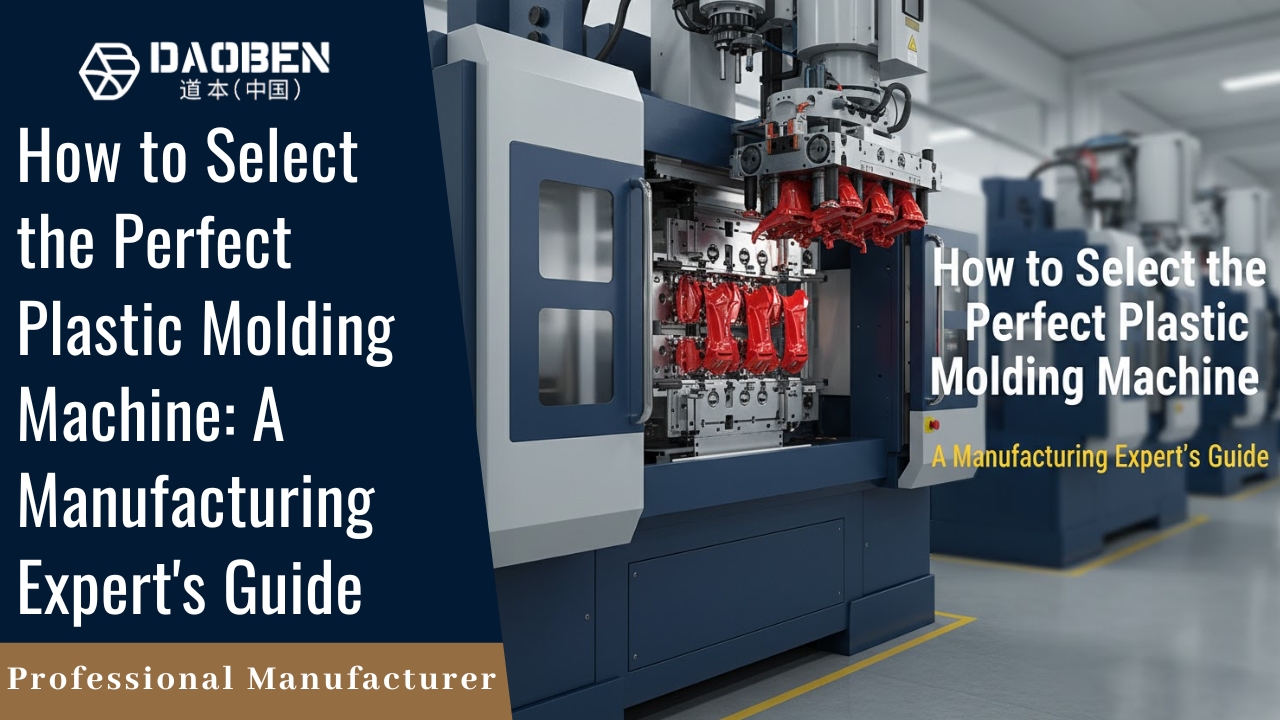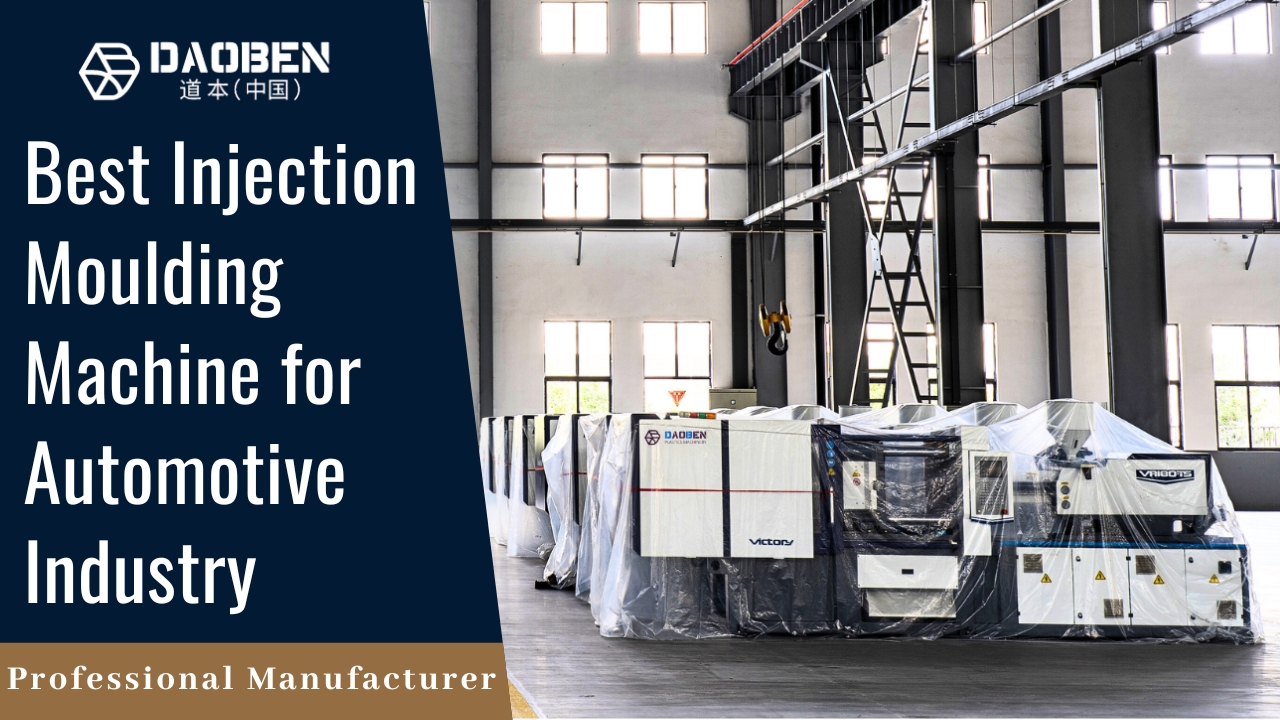You’re under pressure to launch on time, keep costs in check, and hit part quality on the first try. The stakes are real. Pick the wrong press and you’ll fight slow cycles, high scrap, and maintenance headaches. Pick the right one and your line runs smooth for years. This guide shows how to choose injection molding machine specs with confidence—step by step, without fluff—so you can match parts, molds, and production goals with the right plastic molding machine from day one.
We’re Daoben Machinery: a manufacturer of plastic injection machines from 30 ton to 4000 ton. We’ll share the exact checks our engineers use when sizing and configuring an injection molding machine for customers worldwide.
Table of Contents
Toggle- Understanding Your Product First: The Foundation of Selection
- Determining Clamping Force: A Crucial Step in How to Choose Injection Molding Machine
- Evaluating the Injection Unit: Speed and Precision
- Hydraulic vs. All-Electric: Machine Technology Comparison
- Beyond the Specs: Control System and Automation Readiness
- Due Diligence: Manufacturer Support and Reputation
- Final Steps: Simplifying How to Choose Injection Molding Machine
Understanding Your Product First: The Foundation of Selection
Before you look at tonnage or screw diameter, you must analyze the product you plan to make. The part’s material, size, and complexity dictate the type of injection molding machine you need. This critical first step saves you from over-buying or under-buying.
Part Analysis: Material and Size
What material will you run? Are you working with standard materials like PP or PE, or high-performance resins like PEEK or LCP? The material choice affects your machine’s screw design, barrel heating capacity, and pressure requirements.
- Material Type: Different polymers melt and flow at vastly different rates. Highly viscous (thick) materials need more injection pressure and a specific screw compression ratio. For example, processing PVC requires a corrosion-resistant screw and barrel because the material can release corrosive gases.
- Shot Weight and Volume: This is the total weight of the part plus the runner system. The machine’s injection unit must be able to inject this full shot weight with a reserve capacity of about 20%. The shot volume (measured in cubic centimeters) is more precise than weight. You must ensure the chosen machine’s maximum shot volume exceeds your required shot volume.
| Component | Part Requirement | Machine Specification |
| Material | PP (Polypropylene) | Standard Screw/Barrel |
| Material | PC (Polycarbonate) | High Melt Temperature Capacity |
| Shot Weight | 500g (Part + Runner) | Max Shot Weight > 600g |
| Part Volume | 550 cm³ | Max Shot Volume > 650 cm³ |
The Role of the Mold: Dimensions and Weight
The physical size and weight of your mold directly limit the possible machines.
- Tie Bar Distance: The mold must fit between the tie bars of the machine. The distance between the four tie bars determines the maximum width and height of the mold. If you’re running a multi-cavity tool, this is crucial.
- Mold Thickness (Min/Max): The machine’s clamp must accommodate the closed mold height. Too thin, and the clamp can’t build up pressure. Too thick, and it won’t fit at all.
- Mold Weight: The machine’s platens must handle the total mold weight. Check the specifications for maximum platen load.
If you are looking to run specific product lines like plastic chair making machine solutions, the mold size for a chair is substantial, instantly narrowing your machine choices to larger tonnage models. You can review specialized solutions here: plastic chair making machine manufacturer.

Determining Clamping Force: A Crucial Step in How to Choose Injection Molding Machine
Clamping force (or tonnage) is arguably the most important specification. It’s the force the machine uses to keep the mold closed during the injection phase. If the force is too low, the plastic pressure will push the mold open, causing flash (excess material squeezed out at the parting line).
The Tonnage Calculation Formula
The total clamping force required is based on three main factors:
- Projected Area: The total area of the part and runners projected onto the parting line.
- Cavity Pressure: The pressure inside the mold cavity when plastic is injected. This depends on the material, wall thickness, and flow length.
- Safety Factor: A small buffer (usually 10–20%) to ensure consistency.
The simplified formula looks like this:
$$\text{Clamping Force (Tons)} = \frac{\text{Projected Area (in}^2) \times \text{Material Pressure Factor (Tons/in}^2)}{2000}$$
- Material Pressure Factor: This factor is often simplified. For most commodity resins (like PP or HDPE), an estimate of $3\text{ to } 5 \text{ tons per square inch}$ of projected area is common. For harder-to-flow materials (like PC or thick-walled parts), you may use $6 \text{ to } 8 \text{ tons per square inch}$.
Tonnage Range and Machine Size
Daoben Machinery produces machines ranging from small 30 Ton models up to massive 4000 Ton units. Understanding your required tonnage dictates the physical size and cost of the injection molding machine.
- Small (30T – 150T): Ideal for small, precise parts like medical components, small gears, or electronics housings.
- Medium (200T – 500T): Suitable for housewares, automotive interior parts, or simple toolboxes.
- Large (600T – 1500T): Used for larger automotive components, garbage bins, or large household items.
- Extra Large (2000T – 4000T): Necessary for massive parts like automotive bumpers, large pallets, or specialized equipment (see our heavy-duty solutions: 2000ton injection molding machine.
Choosing the right size also impacts your operating costs. A machine that is too big wastes energy.
Evaluating the Injection Unit: Speed and Precision
Once tonnage is set, you look at the injection unit—the part that melts and pushes the plastic. This unit controls shot size, speed, and plasticizing capacity.
Plasticizing Capacity and Cycle Time
Plasticizing capacity refers to how much material the screw can melt and prepare per hour. It must be fast enough to meet your required cycle time.
- Cycle Time: This is the time it takes to make one complete part. It includes clamp close, injection, cooling, and ejection. A faster cycle time means more parts per hour and lower cost per part.
- Screw Diameter: The diameter of the screw determines the maximum shot size. A larger screw means a larger shot size but slower plasticizing. For thin-walled parts requiring fast fill, a smaller L/D (Length-to-Diameter) ratio screw may be better, but often a medium L/D ratio is chosen for versatility.
Injection Speed and Pressure
Some parts, especially thin-walled containers or high-flow parts, need extremely fast injection to prevent the plastic from freezing before the mold is filled.
- High-Speed Requirements: For products like bucket molding machine supplier requirements, the fill time might be less than one second. This needs a machine with specialized accumulators or a high-performance electric drive.
- Maximum Pressure: Ensure the machine can achieve the calculated cavity pressure plus a safety margin. Low pressure means short shots (unfilled parts).

Hydraulic vs. All-Electric: Machine Technology Comparison
The choice between machine types affects precision, energy use, and maintenance. This is a crucial point when deciding the best plastic molding machine for your shop.
The All-Electric Advantage
All-electric machines use servo motors to drive every movement—clamping, injection, and ejection.
- Precision: Exceptional accuracy and repeatability. Ideal for medical, optical, or high-tolerance parts.
- Energy Efficiency: They only draw power when needed, leading to 30–70% energy savings compared to hydraulics.
- Cleanliness: No hydraulic oil means a cleaner manufacturing environment.
- Price: Typically higher initial cost.
The Hydraulic and Hybrid Option
Traditional hydraulic machines are robust and generally lower in initial cost, especially for high-tonnage units. Hybrid machines use a combination, often a hydraulic clamp with an electric screw drive.
- Hydraulic: Great for high clamping force at the lowest initial cost. Durable and proven technology. Better for heavy-duty, long-cycle parts.
- Hybrid: Offers a good balance. The electric drive on the screw provides better energy efficiency for the most power-hungry phase, while the hydraulic clamp keeps the cost lower than a full electric model.
We explore this topic in greater detail, including molding machine pricing factors.
| Feature | All-Electric | Hydraulic | Hybrid |
| Precision/Repeatability | Excellent | Good | Very Good |
| Energy Consumption | Low (Most Efficient) | High (Least Efficient) | Medium (Energy Saver) |
| Initial Cost | Highest | Lowest | Medium-High |
| Maintenance | Low (No Oil) | High (Oil Filters, Leaks) | Medium |
| Ideal For | Medical, Optical, High-Precision | Large Tonnage, Low-Cost Focus | High-Volume, Mid-Tonnage |
Beyond the Specs: Control System and Automation Readiness
A modern plastic molding machine is more than just steel and hydraulics. The control system is the brain, and connectivity is key for a truly efficient factory.
Intuitive Controls and HMI
The operator interface (HMI) must be easy to use. Modern controls offer:
- Real-time Monitoring: Track temperatures, pressures, and cycle times instantly.
- Recipe Storage: Save settings for different molds for fast changeovers.
- Diagnostics: Quickly identify and troubleshoot issues to minimize downtime.
Automation and Auxiliary Equipment
The right machine is designed to work seamlessly with robots, conveyors, and other auxiliaries.
- EUROMAP 67/SPI/OPC UA: Ensure the machine supports standard communication protocols for robotic interfaces. This is non-negotiable for high-volume, automated production lines.
- Core Pulls and Hydraulics: Does the machine have enough hydraulic circuits and tie-in points for your mold’s complex slides or core-pulling mechanisms?
Consider the full solution, not just the machine. See our full range of solutions: [https://www.daobenmachinery.com/mold-injection-machine-solutions/].
Due Diligence: Manufacturer Support and Reputation
Choosing the machine is only half the battle. Choosing the right partner matters just as much.
Support, Training, and Parts Availability
A machine sitting idle costs you money every minute. Ask tough questions about the manufacturer’s commitment.
- Global Service Network: Can the supplier provide technicians quickly to your location?
- Spare Parts Inventory: Are common wear-and-tear parts (screws, barrels, valves) kept in stock, or will you wait months for them?
- Training: Will the manufacturer provide comprehensive training for your technical team?
Daoben Machinery is a well-known name. Our reputation is built on reliability and comprehensive support. We know what it takes to run a high-production facility. You can also explore the market and compare us with others: top injection molding machine brands.
Future-Proofing Your Investment
Technology moves fast. The best purchase is one that you can use efficiently for ten years or more.
- Energy Monitoring: Look for machines with built-in energy monitoring to help manage operating costs.
- Remote Diagnostics: Can the machine be diagnosed remotely over a secure network? This saves time and travel costs for minor issues.
Investing in a robust and flexible machine is key to managing long-term profitability. See how material choices also impact your long-term success: [https://www.daobenmachinery.com/injection-molding-of-plastics/].
Final Steps: Simplifying How to Choose Injection Molding Machine
To simplify the entire process of how to choose injection molding machine, follow this quick checklist. Don’t skip any step.
- Define the Part: Determine shot weight, material, and required precision (tolerance).
- Determine Tonnage: Calculate the minimum required clamping force based on the projected area.
- Check Mold Fit: Verify the tie-bar distance, min/max mold height, and platen size.
- Select Technology: Choose hydraulic, hybrid, or all-electric based on budget, required speed, and energy goals.
- Match Auxiliaries: Ensure the machine supports your robots, dryers, and other necessary equipment.
- Verify Support: Confirm the manufacturer’s warranty, spare parts access, and technical support.
Choosing the ideal plastic molding machine requires a technical deep dive combined with a focus on long-term business goals. Taking the time to select the right equipment is an investment that pays for itself many times over through reduced downtime and higher quality output.




